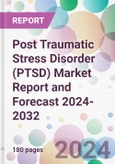Post Traumatic Stress Disorder (PTSD) Market Outlook
The post-traumatic stress disorder (PTSD) market size is expected to grow at a CAGR of 5.4% during the forecast period of 2024-2032 in the major markets, driven by increasing prevalence of post-traumatic stress disorder (PTSD), along with reducing stigma around mental health conditions.Post Traumatic Stress Disorder (PTSD): Introduction
Post Traumatic Stress Disorder (PTSD) is a mental health condition triggered by experiencing or witnessing a terrifying event. Symptoms include flashbacks, nightmares, severe anxiety, and uncontrollable thoughts about the event. Individuals may also experience emotional numbness and avoidance of situations that remind them of the trauma. PTSD can impair daily functioning and relationships. Treatment often involves psychotherapy, medication, or a combination, aiming to improve symptoms, teach coping strategies, and restore normal functioning.Key Trends in the Post Traumatic Stress Disorder (PTSD) Market
There's a growing recognition of PTSD beyond traditional contexts like military veterans, encompassing first responders, victims of abuse, and survivors of accidents or natural disasters. This broader understanding is leading to increased diagnosis rates and a higher demand for treatment services.The market is seeing a shift towards integrated treatment models that combine psychotherapy, medication, and holistic approaches like mindfulness, yoga, and acupuncture. Personalized treatment plans are becoming more common, addressing the individual needs of patients.
Telehealth services, mobile apps, and online therapy platforms are becoming increasingly popular for providing accessible PTSD treatment, especially in remote or underserved areas. Digital platforms also facilitate continuous monitoring and support for individuals with PTSD.
There's a growing emphasis on early intervention and preventive measures in high-risk populations. Programs aimed at education, resilience training, and early trauma counselling are being implemented in various settings, from schools to the military.
The pharmaceutical aspect of the PTSD market is exploring beyond traditional antidepressants. Research into new drug classes and the potential therapeutic use of substances like MDMA and psilocybin for treatment-resistant PTSD is gaining attention.
Increased government funding and supportive regulations for mental health services, including PTSD treatment, are promoting the growth of the market. There's also a trend towards policies that ensure better coverage and access to PTSD therapies under health insurance.
Post Traumatic Stress Disorder Market Segmentation
Market Breakup by Treatment Type
- Drug Administration
- Psychotherapy
Market Breakup by Drug Class
- Antidepressants
- Anti-Anxiety Drugs
- Antipsychotic Drugs
- Others
Market Breakup by Patient Type
- Children
- Adult
Market Breakup by Distribution Channel
- Hospital Pharmacies
- Retail Pharmacies
- Other Distribution Channels
Market Breakup by Region
- United States
- EU-4 and the United Kingdom
- Germany
- France
- Italy
- Spain
- United Kingdom
- Japan
Post Traumatic Stress Disorder (PTSD) Market Overview
In North America, the PTSD market is influenced by a high awareness of mental health issues and robust healthcare infrastructure. The region has a significant number of veterans and active military personnel, leading to focused PTSD research and treatment programs. There's also a growing acceptance of mental health services and an increase in the use of therapy, including cognitive-behavioral therapy and EMDR, coupled with pharmaceutical interventions.Europe's market is characterized by strong mental health policies and a focus on integrated care. The region benefits from universal healthcare systems, ensuring access to mental health services. There's an emphasis on early intervention and community-based support, with countries like the UK and Germany leading in mental health research and therapy services. The market is also influenced by initiatives aimed at reducing the stigma associated with mental health conditions, including PTSD.
The PTSD market in the Japan region is growing, driven by increasing recognition of mental health issues and improving healthcare infrastructure. Cultural factors and stigma associated with mental health can pose challenges. However, there's a gradual shift towards recognizing and treating PTSD, especially in countries with increasing urbanization and changing social dynamics. The market shows potential for growth in therapy services and pharmaceutical treatments, though access to care varies across the region.
Post Traumatic Stress Disorder (PTSD) Market: Competitor Landscape
The key features of the market report include patent analysis, grants analysis, clinical trials analysis, funding and investment analysis, partnerships, and collaborations analysis by the leading key players.- Sanofi-aventis Groupe
- Emergent BioSolutions Inc.
- Valneva SE
- GlaxoSmithKline plc.
- Intervet Inc.
- EuBiologics Co., Ltd.
- Astellas Pharma Inc.
- Celldex Therapeutics.
- Johnson & Johnson Services Inc.
- Merck & Co. Inc.
- Marinus Pharmaceuticals, Inc.
- Tonix Pharmaceuticals Holding Corp.
- Greenstone LLC
- Otsuka Pharmaceutical Co., Ltd
- Prometheon Pharma, LLC.
This product will be delivered within 5-7 business days.
Table of Contents
Companies Mentioned
- Sanofi-aventis Groupe
- Emergent BioSolutions Inc.
- Valneva SE
- GlaxoSmithKline plc.
- Intervet Inc.
- EuBiologics Co. Ltd.
- Astellas Pharma Inc.
- Celldex Therapeutics.
- Johnson & Johnson Services Inc.
- Merck & Co. Inc.
- Marinus Pharmaceuticals Inc.
- Tonix Pharmaceuticals Holding Corp.
- Greenstone LLC
- Otsuka Pharmaceutical Co. Ltd
- Prometheon Pharma LLC.








